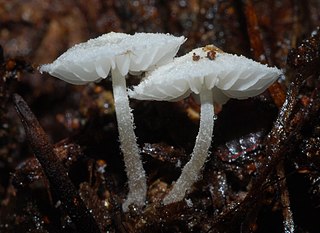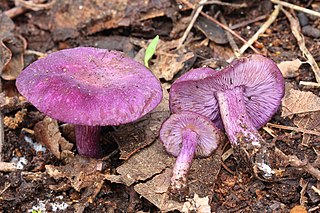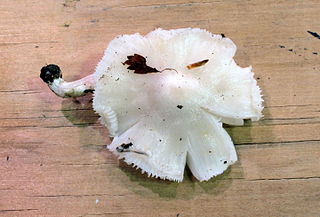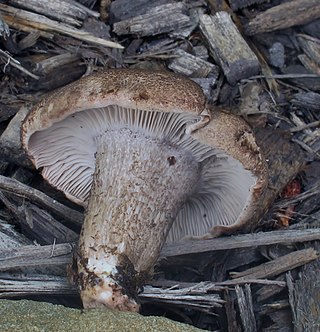| Cyphellocalathus | |
|---|---|
| Scientific classification | |
| Kingdom: | |
| Division: | |
| Class: | |
| Order: | |
| Family: | |
| Genus: | Cyphellocalathus Agerer [1] |
| Type species | |
| Cyphellocalathus cecropiae (Singer) Agerer | |
Cyphellocalathus is a genus of fungi in the family Tricholomataceae. This is a monotypic genus, containing the single species Cyphellocalathus cecropiae, found in Bolivia. [1]

The Tricholomataceae are a large family of fungi within the order Agaricales. Originally a classic "wastebasket taxon", the family included any white-, yellow-, or pink-spored genera in the Agaricales not already classified as belonging to e.g. the Amanitaceae, Lepiotaceae, Hygrophoraceae, Pluteaceae, or Entolomataceae.
Pegleromyces is a genus of fungi in the family Tricholomataceae. It is a monotypic genus, containing the single species Pegleromyces collybioides, found in Brazil, and described as new to science by mycologist Rolf Singer in 1981.

Amparoina is a genus of fungi in the family Tricholomataceae. The genus contains two species found in South America.
Austroclitocybe is a genus of fungi in the family Tricholomataceae. The genus is monotypic, containing the single species Austroclitocybe veronicae, found in temperate South America. The genus was circumscribed by Jörg H. Raithelhuber in 1972.

Cellypha is a genus of fungi in the family Tricholomataceae. The widespread genus contains 10 species.
Clavomphalia is a genus of fungi in the family Tricholomataceae. It is a monotypic genus, containing only Clavomphalia yunnanensis, a Chinese species first described by German mycologist Egon Horak in 1987.
Cynema is a genus of fungi in the family Tricholomataceae. This is a monotypic genus, containing the single species Cynema alutacea, found in Papua New Guinea.
Dennisiomyces is a genus of fungi in the family Tricholomataceae. Described by mycologist Rolf Singer in 1955, the genus contains five species found in South America.

Fayodia is a genus of fungi in the family Tricholomataceae. It was first described by Robert Kühner in Bull. Bi-Mens. Soc. Linn. Lyon Vol.9 on page 68 in 1930, and the specific epithet honors the Swiss mycologist Victor Fayod (1860–1900). The widespread genus contains 10 species, mostly in the northern temperate regions.

Leucocortinarius is a genus of fungus in the family Tricholomataceae. It is a monotypic genus, containing the single species Leucocortinarius bulbiger, found in Europe.

Mycenella is a genus of fungi in the family Tricholomataceae. The widespread genus contains 10 species, found mostly in temperate regions. Mycologist Rolf Singer circumscribed the genus in 1938.

Myxomphalia is a genus of fungi in the family Tricholomataceae. The genus has a widespread distribution in north temperate areas, and contains four species.
Omphaliaster is a genus of fungi in the family Tricholomataceae. The widespread genus contains seven species, predominantly in northern temperate regions.
Physocystidium is a genus of fungi in the family Tricholomataceae. This is a monotypic genus, containing the single species Physocystidium cinnamomeum. This species is found in Trinidad, and was originally described as new to science in 1951 as Collybia cinnamomea by mycologist R.W.G. Dennis; Rolf Singer transferred it to the then newly created genus Physocystidium in 1962.

Pleurella is a genus of fungi in the family Tricholomataceae. This is a monotypic genus, containing the single species Pleurella ardesiaca, found in New Zealand.

Tricholosporum is a genus of fungi in the family Tricholomataceae. It was circumscribed by Mexican mycologist Gastón Guzmán in 1975.
Pseudohygrophorus is a genus of fungi in the family Tricholomataceae. The genus is monotypic, and contains the single species Pseudohygrophorus vesicarius. The species was first described scientifically by the Czech botanist Josef Velenovský in 1939.

Albomagister is a genus of fungi in the family Tricholomataceae. The genus contains just one named species known from Tennessee and North Carolina, however two other undescribed species have been sequenced. Albomagister was described by mycologists Marisol Sánchez-García, Joshua Birkebak & P. Brandon Matheny in 2014 with Albomagister subaustralis as the type species.
Corneriella is a genus of fungi in the family Tricholomataceae. The genus contains two species known from the United States and Thailand, and at least four others have been detected by DNA sequencing. Corneriella was described the mycologist Marisol Sánchez-García in 2014 with Corneriella bambusarum as the type species.

Pseudotricholoma is a genus of fungi in the family Tricholomataceae. The genus contains three species known from North America. Europe, and the Azores. Basidiocarps resemble those of the genus Tricholoma, with a dry fibrillose pileus and white to brown lamellae that have adnate to emarginate attachment and stain reddish when damaged, eventually turning black. Microscopically, the basidiospores are smooth, ellipsoid to ellipsoid-oblong, thin-walled and amyloid. Cheilocystidia are rare to absent and pleurocystidia are absent. The pileipellis is a cutis and clamp connections are present. Species in Pseudotricholoma are found on soil in grasslands and woods. They are probably biotrophic, and may be ectomycorrhizal.